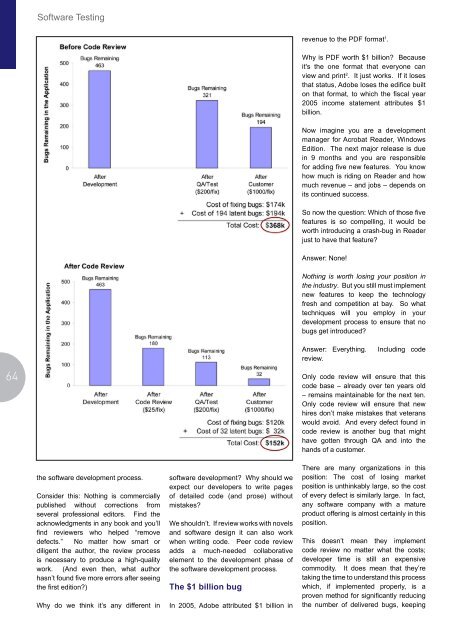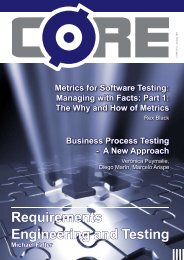Comparison of Change Management Systems
Comparison of Change Management Systems
Comparison of Change Management Systems
You also want an ePaper? Increase the reach of your titles
YUMPU automatically turns print PDFs into web optimized ePapers that Google loves.
64<br />
S<strong>of</strong>tware Testing<br />
the s<strong>of</strong>tware development process.<br />
Consider this: Nothing is commercially<br />
published without corrections from<br />
several pr<strong>of</strong>essional editors. Find the<br />
acknowledgments in any book and you’ll<br />
find reviewers who helped “remove<br />
defects.” No matter how smart or<br />
diligent the author, the review process<br />
is necessary to produce a high-quality<br />
work. (And even then, what author<br />
hasn’t found five more errors after seeing<br />
the first edition?)<br />
Why do we think it’s any different in<br />
s<strong>of</strong>tware development? Why should we<br />
expect our developers to write pages<br />
<strong>of</strong> detailed code (and prose) without<br />
mistakes?<br />
We shouldn’t. If review works with novels<br />
and s<strong>of</strong>tware design it can also work<br />
when writing code. Peer code review<br />
adds a much-needed collaborative<br />
element to the development phase <strong>of</strong><br />
the s<strong>of</strong>tware development process.<br />
The $1 billion bug<br />
In 2005, Adobe attributed $1 billion in<br />
revenue to the PDF format 1 .<br />
Why is PDF worth $1 billion? Because<br />
it's the one format that everyone can<br />
view and print 2 . It just works. If it loses<br />
that status, Adobe loses the edifice built<br />
on that format, to which the fiscal year<br />
2005 income statement attributes $1<br />
billion.<br />
Now imagine you are a development<br />
manager for Acrobat Reader, Windows<br />
Edition. The next major release is due<br />
in 9 months and you are responsible<br />
for adding five new features. You know<br />
how much is riding on Reader and how<br />
much revenue – and jobs – depends on<br />
its continued success.<br />
So now the question: Which <strong>of</strong> those five<br />
features is so compelling, it would be<br />
worth introducing a crash-bug in Reader<br />
just to have that feature?<br />
Answer: None!<br />
Nothing is worth losing your position in<br />
the industry. But you still must implement<br />
new features to keep the technology<br />
fresh and competition at bay. So what<br />
techniques will you employ in your<br />
development process to ensure that no<br />
bugs get introduced?<br />
Answer: Everything. Including code<br />
review.<br />
Only code review will ensure that this<br />
code base – already over ten years old<br />
– remains maintainable for the next ten.<br />
Only code review will ensure that new<br />
hires don’t make mistakes that veterans<br />
would avoid. And every defect found in<br />
code review is another bug that might<br />
have gotten through QA and into the<br />
hands <strong>of</strong> a customer.<br />
There are many organizations in this<br />
position: The cost <strong>of</strong> losing market<br />
position is unthinkably large, so the cost<br />
<strong>of</strong> every defect is similarly large. In fact,<br />
any s<strong>of</strong>tware company with a mature<br />
product <strong>of</strong>fering is almost certainly in this<br />
position.<br />
This doesn’t mean they implement<br />
code review no matter what the costs;<br />
developer time is still an expensive<br />
commodity. It does mean that they’re<br />
taking the time to understand this process<br />
which, if implemented properly, is a<br />
proven method for significantly reducing<br />
the number <strong>of</strong> delivered bugs, keeping



